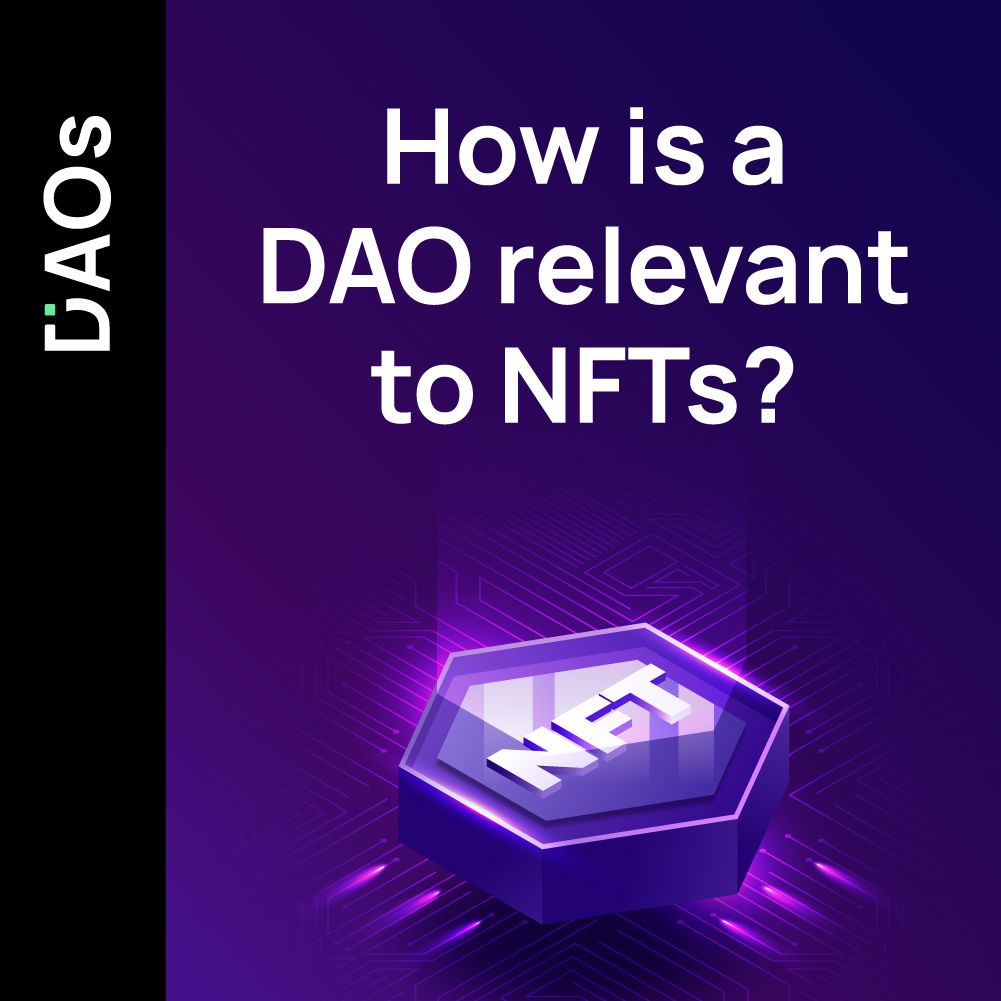14: How is a DAO relevant to NFTs?

DAOs, or Decentralized Autonomous Organizations, are already a revelation in the modern world, with their unending applications in all sectors. They have multiple benefits for the NFTs as well. Many NFT projects have created DAOs to leverage their community-oriented working principles and decentralized structure.
In this article, we look at how DAOs are relevant to NFTs:
First, let's look at a DAO and how it works.
DAOs are organizations that are built on blockchains using smart contracts. DAOs are decentralized, with no central authority controlling the actions of the group and power distributed among its members.
DAO's functions are transparent, and members can participate in the governance through tokens. They have established smart contracts on the blockchain to execute various functions when they meet predetermined conditions.
A central entity does not direct the decisions in a DAO; all decision-making happens through proposals shared with the project community, who then vote on them.
There are many different types of DAOs out there. To learn about them, read this article here.
From effective governance to community building and collective NFT ownership, DAOs benefit NFTs in many ways. Let's explore how.
How are DAOs relevant to NFTs?
Collective Ownership
One of the ways DAOs are directly related to NFTs is through collector DAOs. A collector DAO is an organization that pools together funds to acquire and issue NFTs.
These are decentralized autonomous organizations that pool their funds to purchase NFTs. Large NFT projects come at high prices, and individuals often cannot raise such significant capital alone.
Collector DAOs come into the picture and allow multiple individuals to own prominent NFTs collectively, so each member gets to own a piece of the NFT.
An example of a collector DAO is the APE DAO. They have fragmented the NFT project, 'Bored ape yacht club NFT,' allowing people to be fractional owners of the NFTs.
In general, DAOs support the NFT space by realizing the concept of collective ownership of assets. Most notable NFT projects require huge capital investment, and everyone cannot afford such amounts. DAOs allow joint ownership of assets and enforce it through smart contracts, allowing people to own a fragment of an asset that would otherwise need a significant investment to own as a whole.
Thus DAOs allow people to own NFTs without splurging thousands of dollars.
Let's take the example of PleasrDAO.
PleasrDAO is a collective of DeFi leaders, early NFT collectors, and digital artists who have built a strong reputation for acquiring culturally significant pieces with a charitable twist.
The DAO funds highly valuable NFTs and collects digital artworks representing relevant ideas, principles, and causes. Besides, the members share the cost and ownership in each NFT purchased by the DAO.
It started with the aim to buy a Uniswap V3 NFT, but now it has collected NFTs like Edward Snowden's "Stay Free," worth 2,224 ETH or $5.4 billion at the time of purchase.
PleasrDAO has set a precedent for bidding on unique pieces, many of which have powerful messages that transcend crypto.

Community governance
The connection between DAOs and NFTs goes beyond Collector DAOs. DAOs can also help create NFT projects via community governance. Community members and creators can collaboratively come to decisions and contribute ideas for the future direction of the NFT project.
A new way in which DAOs change the NFT space is by bringing in community governance opportunities. DAOs are a great place to build a community for creators and fans of NFTs. But due to their democratic and decentralized nature, they are a great platform to engage in community building. As a result, many NFT projects have built their DAOs.
A critical factor in all this is community governance, unseen in traditional organizations. Members get to take part in the decision-making process and protocol changes. They can have honest discussions with everyone else in the DAO and make changes within the DAO.
In some cases, the community builds the DAO before they even decide to develop their project. For instance, in MeebitsDAO built by the Larva Labs Meebits NFT project, the community looks to create a metaverse by buying virtual lands in metaverses.
NFT creator collectives and community building
Collector DAOs have the potential to help small-scale projects build a thriving community. Since each creator or artist may not have a vast following, DAOs give them the power to create one.
It allows members to vote and decide the projects they like the most. They also have the functionality of crowdfunding platforms, allowing DAOs to raise capital from interested communities.
A solid and supportive community is the backbone of NFT projects. Building a thriving community is easy for already established artists or celebrities. However, this is not the case for rising artists new to the scene; here is where an NFT creator collective comes into place.
These are collective groups of NFT artists who come together to raise funds, help with community building, help each other in marketing, and much more. Such collectives form DAOs.
Final words
As we have seen, DAOs have multiple uses within the NFT industry. The most significant benefit is the possibility of collective ownership with decentralized governance.
These features help NFT communities to develop online and support NFT creators and collectors in multiple ways. Watch this space for more to see if DAOs can introduce more utilities to the growing NFT space.

